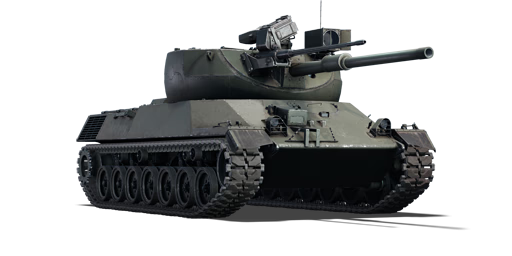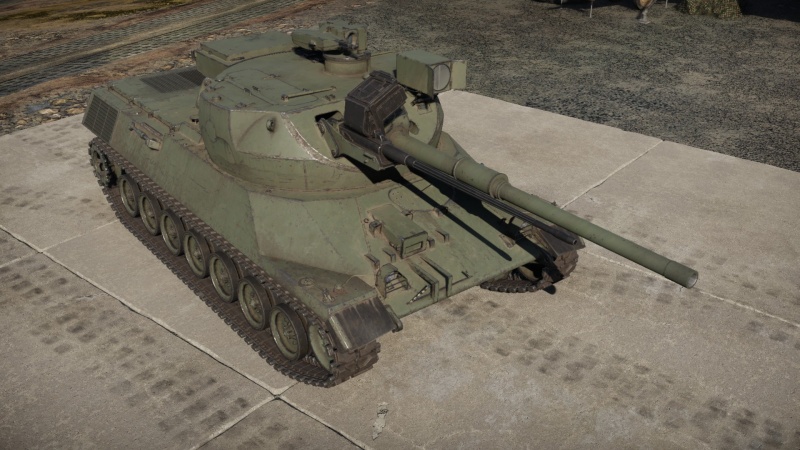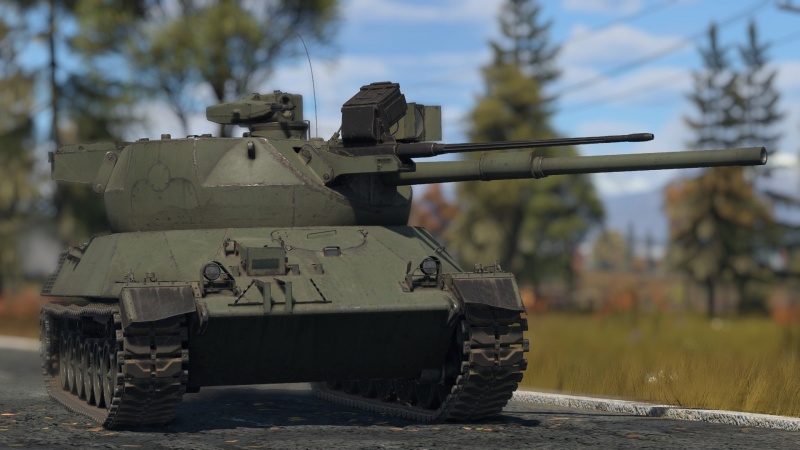Turm III
Contents
Description
The Erprobungsträger mit 3-achs-stabilisiertem Turm is a premium gift rank V German medium tank with a battle rating of 8.3 (AB/RB/SB). It was introduced in Update "Wind of Change".
General info
Survivability and armour
Armour type:
- Rolled homogeneous armour
| Armour | Front (Slope angle) | Sides | Rear | Roof |
|---|---|---|---|---|
| Hull | 30 mm (60°) Front glacis 30 mm (51°) Lower glacis |
20 mm (26°) Top 10 mm (26°) Engine vents 20 mm Bottom |
20 mm Upper plate 20 mm (10°) Lower plate 20 mm (47°) Lower glacis |
30 mm (30°) Front glacis 10 mm Engine compartment |
| Turret | 30 mm (45°) Turret front 20 mm (spherical) Turret ball |
20 mm (spherical) Turret ball | 20 mm (spherical) Turret ball | 10 mm |
| MG cupola | 10 mm | 10 mm | 10 mm | 10 mm |
Notes:
- Suspension wheels, tracks, and torsion bars are 20 mm thick.
Mobility
| Game Mode | Max Speed (km/h) | Weight (tons) | Engine power (horsepower) | Power-to-weight ratio (hp/ton) | |||
|---|---|---|---|---|---|---|---|
| Forward | Reverse | Stock | Upgraded | Stock | Upgraded | ||
| Arcade | 73 | 28 | 42.5 | 1,327 | 1,633 | 31.22 | 38.42 |
| Realistic | 66 | 26 | 757 | 856 | 17.81 | 20.14 | |
Modifications and economy
Armaments
Main armament
| 105 mm L7A3 | Turret rotation speed (°/s) | Reloading rate (seconds) | |||||||||||
|---|---|---|---|---|---|---|---|---|---|---|---|---|---|
| Mode | Capacity | Vertical | Horizontal | Stabilizer | Stock | Upgraded | Full | Expert | Aced | Stock | Full | Expert | Aced |
| Arcade | 47 | ±12° | ±180° | Two-plane | 22.8 | 31.6 | 38.4 | 42.5 | 45.2 | 5.00 | 5.00 | 5.00 | 5.00 |
| Realistic | 14.3 | 16.8 | 20.4 | 22.6 | 24.0 | ||||||||
Ammunition
- DM13; APDS (Armour-Piercing Discarding Sabot) will comfortably penetrate the armour of most foes; be aware however that some vehicles such as the IS-4 or M103 are only vulnerable in specific weak spots. APDS rounds do require some finesse with their placement due to their lack of explosive filler. Unless you're confident you can destroy the enemy before they can respond, you should attempt to disable their weaponry first to ensure your own safety. Against targets with known ammunition storage, it's possible to try to detonate it with a well-placed shot. Keep in mind, however, that ammo detonations always occur with a random chance, so taking out crew members is a more reliable method to destroy your enemies. This, of course, requires knowledge about the vehicles you may face - so be sure to use the game's X-Ray view in the hangar and analyse your potential foes for their weak spots! Also, keep in mind that with increased armour thickness, the amount of shrapnel shrinks.
- DM512; HESH (High-Explosive Squash-Head) works very differently than other shell types. It ignores any angle, except for ricochet and deals damage by metal-flakes which are blown off inside the armour by the exterior explosion. To create this deadly shrapnel inside the tank, make sure to only hit armour plates which are directly adjacent to the interior crew compartment of the tank. Hitting exterior parts of a tank like spaced armour, the suspension, tracks etc. will not harm crew members/modules at all. Unfortunately, HESH is particularly ineffective against particularly high true armour values (as opposed to high 'effective' armour values sourced from highly angled but thin armour - HESH loves angles!). Like all high-explosive shells, the fuse is very sensitive and can be set-off by most objects e.g. fences, trees, shrubbery. The low muzzle velocity of this shell can make it quite hard to hit targets at larger distances, although an experienced tanker may be able to use this to their advantage by lobbing a round over a small defilade or hill. It's also worth noting that HESH can be rather unreliable at times; it's best used as a fall-back ammo, or saved for particularly lightly armoured targets.
- DM12; HEATFS (High-Explosive Anti Tank Fin-Stabilised): Knowledge of potential opponents vehicle layouts can be very handy - as you now have a round at your disposal that can penetrate essentially any vehicle's armour frontally. Like the APDS shot, increased armour thickness results in a reduced amount of shrapnel after penetration. You are able to take out enemies on any distance since the HEAT round does not lose penetration effectiveness with distance - very handy on big scaled maps like Kursk. There is, however, a significant downside to HEATFS. Given that it is a chemical energy round, its fuse is highly sensitive in regards to its practical application in battle. As a result, virtually anything, such as trees or even a fence, will set it off prematurely, so you cannot fire through obstructions with this kind of round. It's often a good idea to clear bushes and fences with your machine guns quickly before taking a shot. Finally, the HEATFS round is relatively expensive in terms of SL, so keep that in mind when loading up.
| Penetration statistics | |||||||
|---|---|---|---|---|---|---|---|
| Ammunition | Type of warhead |
Penetration @ 0° Angle of Attack (mm) | |||||
| 10 m | 100 m | 500 m | 1,000 m | 1,500 m | 2,000 m | ||
| DM13 | APDS | 350 | 347 | 333 | 317 | 302 | 287 |
| DM512 | HESH | 127 | 127 | 127 | 127 | 127 | 127 |
| DM12 | HEATFS | 400 | 400 | 400 | 400 | 400 | 400 |
| Shell details | ||||||||||||
|---|---|---|---|---|---|---|---|---|---|---|---|---|
| Ammunition | Type of warhead |
Velocity (m/s) |
Projectile mass (kg) |
Fuse delay (m) |
Fuse sensitivity (mm) |
Explosive mass (TNT equivalent) (kg) |
Ricochet | |||||
| 0% | 50% | 100% | ||||||||||
| DM13 | APDS | 1,478 | 4 | - | - | - | 75° | 78° | 80° | |||
| DM512 | HESH | 732 | 11.2 | 0.1 | 4 | 4.31 | 73° | 77° | 80° | |||
| DM12 | HEATFS | 1,174 | 10.5 | 0.05 | 0.1 | 1.27 | 65° | 72° | 77° | |||
Ammo racks
| Full ammo |
1st rack empty |
2nd rack empty |
3rd rack empty |
4th rack empty |
5th rack empty |
6th rack empty |
Visual discrepancy |
|---|---|---|---|---|---|---|---|
| 47 | __ (+__) | __ (+__) | __ (+__) | __ (+__) | __ (+__) | __ (+__) | __ |
Notes:
- Shells are modeled individually, and disappear when fired.
Additional armament
| 30 mm HSS 831L | Reloading rate (seconds) | |||||||
|---|---|---|---|---|---|---|---|---|
| Capacity (Belt) | Fire rate | Vertical | Horizontal | Stabilizer | Stock | Full | Expert | Aced |
| 300 (50) | 600 | N/A | N/A | N/A | 15.00 | 15.00 | 15.00 | 15.00 |
Ammunition
- Default: SAP-I · HEI-T*
| Penetration statistics | |||||||
|---|---|---|---|---|---|---|---|
| Ammunition | Penetration @ 0° Angle of Attack (mm) | ||||||
| 10 m | 100 m | 500 m | 1,000 m | 1,500 m | 2,000 m | ||
| SAP-I | 53 | 50 | 39 | 29 | 21 | 16 | |
| HEI-T* | 9 | 8 | 7 | 5 | 4 | 4 | |
| Shell details | ||||||||||||
|---|---|---|---|---|---|---|---|---|---|---|---|---|
| Ammunition | Velocity (m/s) |
Projectile mass (kg) |
Fuse delay (m) |
Fuse sensitivity (mm) |
Explosive mass (TNT equivalent) (g) |
Ricochet | ||||||
| 0% | 50% | 100% | ||||||||||
| SAP-I | 1,080 | 0.36 | 1.2 | 9 | 30.6 | 47° | 56° | 65° | ||||
| HEI-T* | 1,080 | 0.36 | 0.1 | 0.1 | 85 | 79° | 80° | 81° | ||||
Ammo racks
| Full ammo |
1st rack empty |
2nd rack empty |
3rd rack empty |
4th rack empty |
5th rack empty |
6th rack empty |
Visual discrepancy |
|---|---|---|---|---|---|---|---|
| 6 | __ (+__) | __ (+__) | __ (+__) | __ (+__) | __ (+__) | __ (+__) | __ |
Machine guns
| 7.62 mm MG3A1 | ||||
|---|---|---|---|---|
| Mount | Capacity (Belt) | Fire rate | Vertical | Horizontal |
| Pintle | 2,000 (200) | 1,200 | -8°/+25° | ±180° |
Usage in battles
Describe the tactics of playing in the vehicle, the features of using vehicles in the team and advice on tactics. Refrain from creating a "guide" - do not impose a single point of view but instead give the reader food for thought. Describe the most dangerous enemies and give recommendations on fighting them. If necessary, note the specifics of the game in different modes (AB, RB, SB).
Pros and cons
Pros:
- Huge first stage ammo rack
- Has a fast autoloader for the main armament
- Has an autocannon for coaxial weapon that can defeat even some MBTs through the side armour
- Extremely good mobility, can easily get up to 66 kilometres per hour in RB
- Two-axis stabilizer, unlike its equivalent counterpart, the Leopard I
- Weak armour can cause some shells to over-penetrate and do almost nothing
- Familiar Leopard 1 chassis
Cons:
- Nearly nonexistent armour
- Ammunition practically fills up the turret ball, making almost any shell that penetrates end up detonating it
- Machine gun cannot aim directly level to the main gun, making it disorienting when you are reloading the 30 mm autocannon and want to spray a lightly armoured target
- Poor gun elevation, making it difficult to use the 30 mm against aircraft
Arbeitsgruppe C (Borgward) proposed a design featuring a stabilized autoloading turret for the Europanzer project in 1958. However, they failed to produce two prototypes before the deadline due to the high development risks. Some point later, during the development process of the MBT-70, engineers decided to examine the practicality of triaxial stabilization more closely with a functional model. With a three-axis stabilized turret, you could improve the hit probability by correcting the longitudianl axial tilt of the main gun.In the mid-1960s, Rheinische Stahlwerke (then Rheinstahl-Hanomag) and AEG (then AEG-Telefunken) developed a functional model. Rheinstahl-Hanomag received the build order; While the electrical turret drives and controls were developed by Telefunken AG.
Turret III featured a 105mm L7A2, a coaxial 30mm HS 831A automatic cannon and a 7.62mm MG3 on the commander's optics. The primary and secondary weapons were rigidly mounted. So, the secondary does not have a directing system independent of the primary weapon. The lower half of the turret was spherical to allow longitudinal axial tilt. The turret was mounted gimballed in a chassis, decoupled from the rotary movements of the vehicle. The left hemisphere of the turret accommodated the crew compartment of three. The right hemisphere housed the ammunition supply and autoloader. The stern of the turret was a cooling system for the crew fighting compartment. The combat weight of the turret was 17.75 tons.
Turret III was placed on a chassis that, for logistical reasons, contained the drive and running gear elements of the Leopard 1. The chassis was made of mild steel and widened to 3.51 meters. An auxiliary motor (74 kW) was placed in the chassis to supply the turret drives and stabilization system. Arranged in the middle of the vehicle's bow was the driver's seat. The driver's control panel actuated the accelerator, brake and steering. The transmission shifted automatically. When the crew hatches were closed, the driver would see using the driver's TV set. If necessary, the commander could take over the function of the driver from the turret; They installed a camera on the upper front plate for this purpose. The commander could also operate the central control unit (fire control system) just as equally as the gunner.
There is no available information regarding the results of the tests. However, it's safe to assume that the complex turret drives frequently tended to fail. The placement of the drive elements made them difficult to access. So, for technical and cost reasons, the triaxial stabilizer was never implemented into production. Today, main battle tanks use a gyro to account for the axial tilt.
Media
- Skins
See also
- Related development
External links
| Germany medium tanks | |
|---|---|
| Pz.III | Pz.III B · Pz.III E · Pz.III F · Pz.III J · Pz.III J1 · Pz.III J1 TD · Pz.III L · Pz.III M · Pz.III N |
| Pz.IV | Pz.IV C · Pz.IV E · Pz.IV F1 · Pz.IV F2 · Pz.IV G · Pz.IV H · Pz.IV J · Pz.Bef.Wg.IV J |
| Pz.V | VK 3002 (M) · Panther A · Panther D · Panther F · Panther G · Ersatz M10 · Panther II |
| M48 upgrades | M48A2 G A2 · M48 Super |
| Leopard 1 | Leopard I · Leopard A1A1 · Leopard A1A1 (L/44) · Leopard 1A5 · C2A1 · Turm III |
| Leopard 2 | PT-16/T14 mod. · Leopard 2K · Leopard 2AV |
| Leopard 2A4 · Leopard 2 (PzBtl 123) · Leopard 2A4M · Leopard 2 PL · Leopard 2A5 · Leopard 2 PSO · Leopard 2A6 · Leopard 2A7V | |
| Trophies | ▀M4 748 (a) · ▀T 34 747 (r) |
| Other | Nb.Fz. · KPz-70 |
| USA | mKPz M47 G · M48A2 C |
| USSR | ◊T-72M1 |
| Germany premium ground vehicles | |
|---|---|
| Light tanks | Pz.II C (DAK) · Pz.Sfl.Ic · Pz.Sp.Wg.P204(f) KwK · Sd.Kfz. 140/1 · Sd.Kfz.234/1 · Ru 251 · SPz 12-3 LGS · TAM 2IP |
| Medium tanks | Nb.Fz. · Pz.III N · Pz.Bef.Wg.IV J · ▀M4 748 (a) · ▀T 34 747 (r) · Ersatz M10 |
| mKPz M47 G · Turm III · Leopard A1A1 (L/44) · Leopard 2 (PzBtl 123) · Leopard 2A4M | |
| Heavy tanks | ▀Pz.Kpfw. Churchill · ▀KV-IB · ▀KW I C 756 (r) · ▀KW II 754 (r) |
| VK 45.01 (P) · ␠Tiger · Pz.Bef.Wg.VI P · Tiger II (H) Sla.16 | |
| Tank destroyers | Sd.Kfz.234/3 · Sd.Kfz.234/4 · Sd.Kfz.251/10 · Sd.Kfz.251/22 · 15 cm Pz.W.42 |
| Brummbär · Panzer IV/70(A) · VFW · Bfw. Jagdpanther G1 · Elefant · 38 cm Sturmmörser | |






